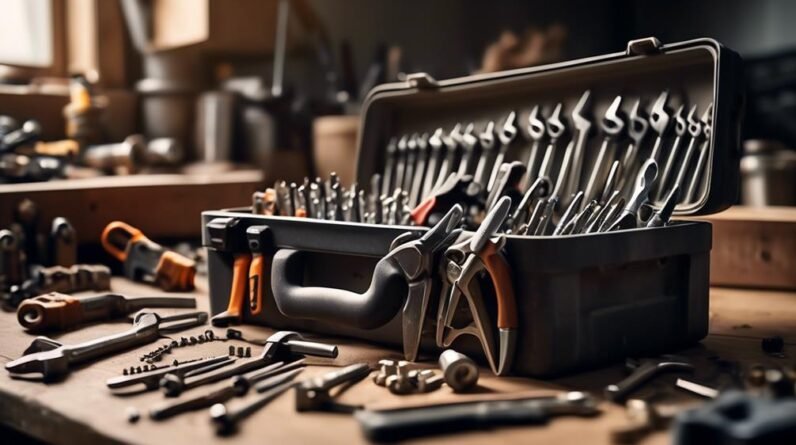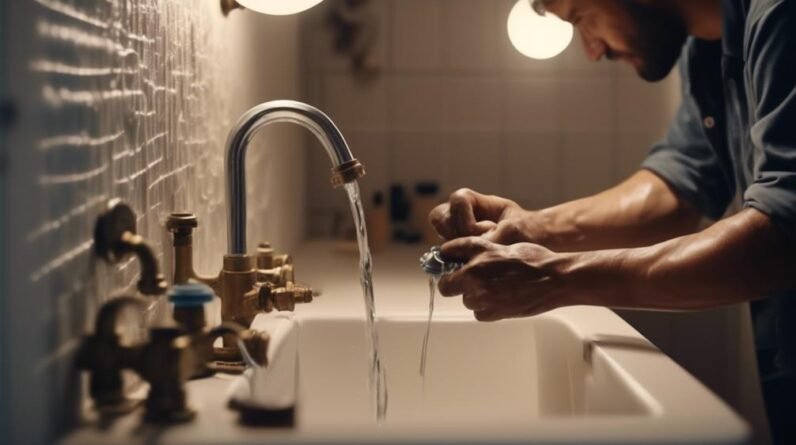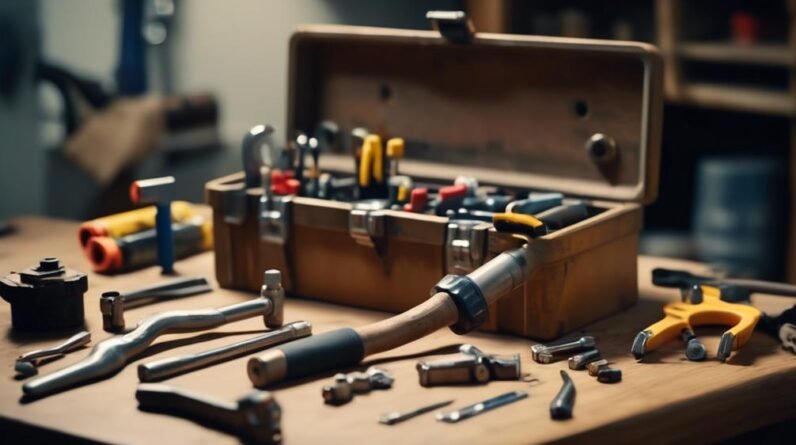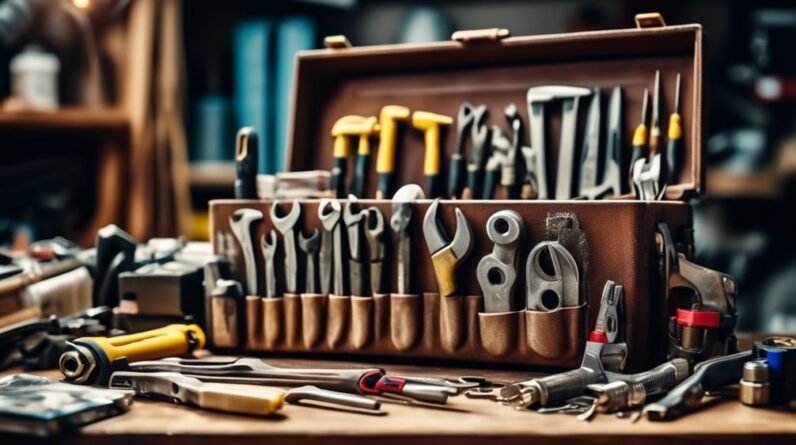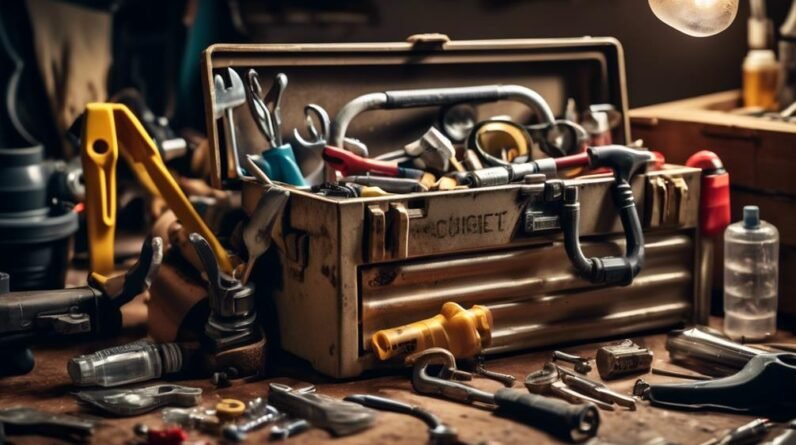
Did you know that the average American household spends over $2,000 each year on home repairs and maintenance? That's a significant amount of money that could be saved by learning a few cost-saving DIY hacks for common household fixes. Whether it's fixing leaky faucets, repairing squeaky doors, patching cracked tiles, or unclogging drains, there are simple and affordable solutions that you can implement yourself. In this discussion, we will explore some practical tips and tricks that will not only help you save money but also empower you to take control of your home's maintenance. So, why continue wasting your hard-earned cash when you can tackle these fixes on your own?
Key Takeaways
- Fixing leaky faucets can save money on water bills and promote water conservation. The most common causes of faucet leaks are worn-out washers and loose or damaged O-rings.
- To repair squeaky doors, lubricate the hinges with WD-40 or silicone-based spray to reduce friction. Tighten loose screws on hinges or door frame and check and align the striker plate with the door latch. Consider replacing worn-out hinges if the problem persists.
- When patching cracked tiles, clean the cracked tile and surrounding area with mild detergent and water. Apply epoxy adhesive to the crack and smooth it with a putty knife. Mix and apply filler compound, leveling it with the surrounding tile surface. Allow the filler to dry completely before sanding it flush.
- To unclog drains, regularly clean drain stoppers and strainers to prevent debris buildup. Pour boiling water down drains to dissolve grease and residue. Use baking soda and vinegar as a natural drain cleaner. Consider investing in a drain snake or auger to remove stubborn clogs. Avoid pouring grease, oil, and food scraps down the drain.
Fixing Leaky Faucets
If you have a leaky faucet, don't worry – fixing it is easier than you might think. Not only will fixing a leaky faucet save you money on your water bill, but it is also an essential step in water conservation strategies. There are several types of faucet leaks, each with its own causes.
The most common type of faucet leak is a worn-out washer. Over time, the washer becomes worn and starts to deteriorate, causing water to leak out. Another common cause is a loose or damaged O-ring. The O-ring is a rubber ring around the valve stem that helps create a watertight seal. If it is loose or damaged, water can leak out.
To fix a leaky faucet, start by turning off the water supply under the sink. Then, using a wrench, remove the handle and the packing nut. Once you have access to the valve stem, inspect the washer and the O-ring for any signs of wear or damage. If necessary, replace them with new ones.
Fixing a leaky faucet is a simple and cost-effective way to save water and money. By understanding the types of faucet leaks and their causes, you can quickly and easily fix the problem yourself.
Repairing Squeaky Doors
Now that you've successfully fixed your leaky faucet, let's move on to the next household fix: repairing squeaky doors. Squeaky doors can be a major annoyance, but luckily, they are relatively easy to fix. Here are a few tips to help you get those doors back to their smooth, silent glory:
- Lubricate the hinges: One of the most common causes of squeaky doors is dry hinges. Applying a lubricant like WD-40 or a silicone-based spray can help reduce friction and eliminate the squeak.
- Tighten the screws: Loose screws can also contribute to squeaky doors. Grab a screwdriver and tighten any loose screws you find on the hinges or the door frame. This simple step can make a big difference.
- Check the striker plate: If the squeak persists, the problem might lie with the striker plate. Ensure that it is properly aligned with the door latch and adjust it if necessary.
- Use a graphite lubricant: If you prefer a more long-lasting solution, try using a graphite lubricant. Apply it to the hinges and work the door back and forth to distribute the lubricant evenly.
- Consider replacing worn-out hinges: If all else fails, it might be time to replace the hinges altogether. Worn-out hinges can cause persistent squeaking, and replacing them can provide a permanent solution.
Patching Cracked Tiles
To patch cracked tiles, gather the necessary materials and follow these simple steps. First, you will need a tile repair kit, which typically includes epoxy adhesive and a filler compound. Additionally, you will need a putty knife, sandpaper, and a damp cloth.
Start by cleaning the cracked tile and the surrounding area with a mild detergent and water. Then, use the putty knife to apply the epoxy adhesive to the crack, making sure to fill it completely. Smooth out the adhesive with the putty knife, removing any excess.
Next, mix the filler compound according to the manufacturer's instructions. Apply the filler to the crack, using the putty knife to ensure it is level with the surrounding tile surface. Allow the filler to dry completely.
Once dry, use sandpaper to gently smooth the repaired area until it is flush with the rest of the tile. Wipe away any dust with a damp cloth.
Unclogging Drains
After successfully patching cracked tiles, it's time to address the next household fix: unclogging drains. Dealing with a clogged drain can be a frustrating experience, but with a few simple DIY drain cleaning methods, you can save yourself time and money. Here are some practical tips to prevent drain clogs and keep your pipes flowing freely:
- Regularly clean your drain stoppers and strainers to prevent hair, soap scum, and other debris from accumulating.
- Pour boiling water down your drains once a week to help dissolve any grease or residue buildup.
- Use a mixture of baking soda and vinegar to create a natural, eco-friendly drain cleaner. Simply pour the baking soda down the drain, followed by the vinegar, and let it sit for a few minutes before flushing with hot water.
- Invest in a drain snake or auger to remove stubborn clogs. These tools can reach deep into the pipes and dislodge any blockages.
- Avoid pouring grease, oil, coffee grounds, and other food scraps down the drain. Instead, dispose of them in the trash or compost bin.
Painting Tips and Tricks
For a professional-looking paint job, follow these practical tips and tricks. When it comes to painting, technique is key. Start by preparing the surface properly. Clean it thoroughly and sand any rough areas to ensure a smooth finish. Use a primer before applying the paint to improve adhesion and enhance the durability of the finish. When choosing the right paint colors, consider the mood and atmosphere you want to create in the room. Lighter colors can make a space feel more open and airy, while darker colors can add depth and coziness. Experiment with color swatches and test patches on the wall to see how they look in different lighting conditions. To achieve a smooth and even finish, use high-quality brushes and rollers. Apply the paint in thin, even coats, allowing each coat to dry completely before applying the next. This will help prevent drips and streaks. Lastly, don't forget to protect your floors and furniture by using drop cloths and painter's tape. Following these tips and tricks will ensure that your paint job looks professional and lasts for years to come.
Frequently Asked Questions
How Can I Prevent My Faucets From Leaking in the First Place?
To prevent faucet leaks, you should regularly check for worn-out washers, loose connections, or corroded pipes. Keep an eye out for high water pressure, as it can cause leaks. Fix any issues promptly to avoid costly repairs later on.
Are There Any Natural Remedies for Fixing Squeaky Doors?
To fix squeaky doors, try natural remedies like applying a lubricant such as WD-40 or vegetable oil to the hinges. If that doesn't work, you can also try tightening the screws or using a doorstop.
What Should I Do if the Crack in My Tile Is Too Large to Patch?
If the crack in your tile is too large to patch, you should consider replacing the tile completely. Alternatively, you can use epoxy resin for a more durable fix. It's important to choose the best option based on your budget and the extent of the damage.
Are There Any DIY Methods for Unclogging Drains That Don't Involve Chemicals?
If you want to unclog drains without using chemicals, there are DIY methods you can try. For example, using a plunger or a combination of baking soda and vinegar can be effective alternatives.
Can You Provide Tips on How to Choose the Right Paint Color for a Room?
When choosing paint colors for a room, consider the psychology of color and how it will impact the space. Use warm tones for a cozy feel, cool tones for a calming effect. Experiment with samples before committing.
Conclusion
In conclusion, these cost-saving DIY hacks for household fixes provide practical and knowledgeable solutions to common problems. By following these tips, you can easily fix leaky faucets, repair squeaky doors, patch cracked tiles, unclog drains, and even enhance your painting skills. With these simple and effective techniques, you can save money and tackle household repairs with confidence.


